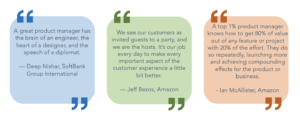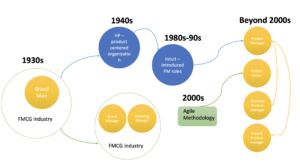Every product manager went through this conversation at one point in their life:
Fiend: “What do you do?”
Me:”I am a Product Manager”
Friend: “Oh, Okay you are a Project Manager”
Me: “No, I am a Product NOT Project Manager”
Friend: ” Product Manager? What is that?” (looking confused)
Me: ” Yeah, I am a product manager who works with different teams to build cool applications in software industry”
f you are a product manager like me, I am quite certain you might have experienced above conversation with your friends or family. In my friend’s defence this reaction is understandable because this role of product manager is not very old. A Product manager is a customer’s voice inside the organization who works with different teams to build a product that can solve a customer’s problem. This left me wondering how did this role began after all? So let us read more and learn about origin of the product manager role and how it evolved to its current shape.

History of Product Manager Role
Product manager role came into existence back in 1930’s when Neil McElroy, a junior executive in the marketing department from Proctor and Gamble was given a responsibility to make Camay soap a successful brand. P&G at that time had a policy that other products should not hurt their flagship product ‘Ivory’ soap and this was making Neil’s job difficult as Camay was competing with Ivory in the same market. Neil a graduate from Harvard then came up with a memo which was a proposal to hire dedicated men focused on building the brands called as ‘Brand Men’. These ‘Brand Men’ as per the memo were responsible for tracking sales, managing the product, advertising and promotions for a specific brand. Eventually his suggestion was acknowledged and approved which led to the birth of Brand Management. This approach of brand management was eventually adopted across FMCG industry. Lets take a closer look at the job description of ‘Brand men’ from the memo and how it translates to today’s world in tech industry
“Study carefully shipments of his brands by units”
Understanding the market and the target segment, user’s pain points and how your product is reaching the end user.
“Where brand development is heavy and progressing, examine carefully the combination of effort that seems to be clicking and try to apply this same treatment to other territories”
Understand the feature adoption, what end users like and their journey. Also, analyze any patterns among end user segments where the adoption of features is less.
“Develop a plan that can be applied to this local store spot.It is necessary of course not only to work out the plan but also to be sure that the amount of money proposed can be expected to produce results at a reasonable cost per case.”
Go to market strategy, analyze the 4 Ps-product, price, place, promotion. Monitor the revenue metrics- LTV,ARPU etc.
“Prepare sales helps and all other necessary material for carrying out the plan. Pass it on to the districts. Work with salesman while they are getting started.Follow through to the very finish to be sure that there is no let-down in sales operation of the plan”
Help in RFPs, by providing the sales team up to date information about the latest features implemented and also take feedback on what could be the future potential product features
” Keep whatever records are necessary, make whatever field studies are necessary to determine whether plan has produced the expected results
Analyze customer reviews, conduct surveys, gather data and analyze data to measure the KPIs and if the expected goal has been achieved post launch.
“Experiment with and recommend wrapper revisions”
Continuously work on the product based on the feedback from various sources and strive to make the product better with each iteration.
“When the brand men have approached their fullest responsibilities, they should be able to take from the shoulders of the Division Managers and of the District Managers a very heavy share of individual brand responsibility.”
“This would leave the sales heads in a much freer position to administer the sales policies of the Company and apply general volume of pressure without having to give such a large proportion of their time to thought on how to bring up volume on a certain brand”
Do whatever it takes to get the job done, collaborate with various teams like engineering, designers, QAs, sales, customer success and key stakeholders to build a product that solves the customers problem. Keep the team focused on their goal and direct the team to build the right product in the right way.
If you are a Product Manager, I am sure you can relate to the statements from the memo. The concept is still same, difference is that the Brand Managers are working in a consumer product industry and are responsible for product’s quality, marketing and advertising where as a Product Manager is a customer’s voice involved in formulating the overall product strategy and is responsible for a products success in a technology industry.
Niel McElory also came in contact with two young entrepreneurs called Bill Hewlett and David Packard at Stanford during late 1930s. This duo then went on to create HP, a well known brand today. Bill and David adsorbed McElory’s ideas and created a product centered organization, with self sustaining product groups responsible for developing, manufacturing and marketing of a product. This was the period when ‘Brand Men’ was taking the shape of a Product Manager.

The 80s to 90s era
During this time, when the employees of P&G started moving out of the organization, the product management concept also got more adoption. One of the first companies that adopted product management was Intuit. Intuit, a tax preparation, financial and accounting software company was founded by Scott Cook and Tom Proulx in 1983. Scott was earlier a ‘Brand Man’ at Procter & Gamble. Scott implemented the customer centric approach at Intuit which led to their first product ‘Quicken’. Microsoft later followed the same foot steps and introduced Product Manager role in their teams.
The last decade
Companies have realized in the last decade that engineers are not sufficient alone to implement features solving customer problems. There is a need of a middle man to translate the business problems into technical tasks. Somebody is needed who can work with the key stakeholders, align on the features to be implemented, define a product roadmap, define the features and work with other team members to build a product inculcating the customer’s feedback as they are the voice of the customer. However, there are various versions of Product Manager role in today’s world. Let us take a look at some of the most common product manager role variations:
- Product Owner : The Product owner is responsible for overseeing the product development and making sure the business requirements are implemented as expected in SDLC cycle. The product owner needs to coordinate with Product Manager to remain updated on the business requirements and make adjustments if needed at any time and then convey it to the teams involved.
- Product Manager : This person is responsible for the product at a higher level, and creates product roadmaps, aligns with key stakeholders for scoping the product features and collaborates with sales, marketing, customer success, engineering and design teams to steer the product strategy and development.
- Technical Product Manager : This role is essentially a product manager working in a software company but will probably need to understand technology at a deeper level and work in coordination with the development team to formulate the product strategy and lead the product development. Most of the times this role needs the individual to be aware of the technical details involved in building the product.
- Product Marketing Manager : Product marketing role is focused on the product and marketing. The major responsibility of this role is creating Go to market strategy for the product by working in collaboration with product manager, sales, marketing, customer success teams.
- Growth Product Manager : This role focuses on growing the business. Primary responsibility is to increase the end users and improve the business metrics like retention, acquisition. They can also be referred as Product Growth Managers.
- Senior Product Manager: They have the same responsibilities as of a Product Manager but also lead and mentor a group of other product managers.

